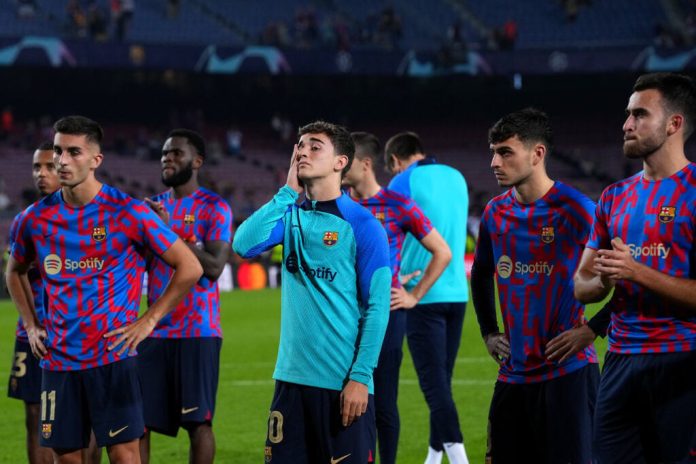The summer transfer window is in full swing with the Premier League and Saudi Arabia’s Pro League flexing their financial muscles, but the concerning downfall of Spanish football is reflected by La Liga’s spending, or lack thereof.
La Liga Spending Compared
- Premier League: €1.34bn
- Serie A: €531m
- Ligue 1: €456m
- Bundesliga: €448m
- Saudi Arabia: €301m
- La Liga: €250m
Figures courtesy of Transfermarkt.
It comes as no surprise to see the Premier League leaps and bounds ahead of the window’s next-nearest spenders. The English top-flight is projected to break its own spending record this summer and surpass the £2bn mark for the first time.
The commercial pulling power of the Premier League has accelerated at an alarming rate, while the rest of Europe’s top five leagues have struggled to recover from the impact of the coronavirus pandemic.
Leaving the rest of the competition in the dust is a worrying prospect for the rest of the continent, who are already feeling the effects of players eager to move to England – even if it means joining an inferior team.
La Liga president Javier Tebas made his feelings felt after the Premier League spent more than the rest of Europe combined back in January, which is historically the quieter window.
Chelsea alone spent more than Europe’s top five leagues combined, to which he expressed a sharp retort. Tebas said: “The British market is a doped market.
“You can see it clearly in this winter market, where Chelsea have made almost half of the signings in the Premier League. It is quite dangerous that the markets are doped, inflated, as has been happening in recent years in Europe, because that can jeopardise the sustainability of European football.”
La Liga Spending Highlights Waining Influence
Tebas went on to make a bold claim, saying that the teams in La Liga are “economically sustainable” and have secure futures “for many years to come.”
This statement could not be further from the truth.
In a push to dispel any suggestions that Spanish clubs were failing to align with UEFA’s Financial Fair regulations, Tebas kept spending limits in place during the pandemic.
UEFA suspended their regulations to help teams relieve the economic pressures of the pandemic, but Spanish clubs were still subject to stringent limits which has put strain on spending.
It has also put further pressures on teams to sell players in order to properly align with wage regulations, which in turn has seen the league’s pull become weaker.
Barcelona are of course the prime example of La Liga’s waining economic influence. Years of corruption and gross mismanagement from Sandro Rosell – and latterly Josep Bartomeu – has left returning president Joan Laporta picking up the pieces.
He has been forced to strip the club to its core, selling off merchandising and broadcasting rights as so-called ‘economic levers’ to ultimately secure the future of the club.
What this means for the future remains to be seen, but these levers are strictly short-term solutions and the club’s tenuous relationship with La Liga has seen them struggle to register players in recent seasons.
They did indeed manage to lift the league title last season, but their ability to lean on the biggest key sponsorship package in world football is in stark contrast to the rest of the league.
You only have to look past the league’s top two to find examples of La Liga’s sharp decline.
Atletico Madrid were one of the most powerful clubs in Europe a decade ago, reaching two separate Champions League finals in the 2010’s.
Diego Simeone’s influence, along with Gil Marin and Enrique Cerezo in the director’s box, has begun to stagnate. New chief investors have also done little to inject the necessary cash in the right areas – for context, Simeone is still the highest paid manager in world football.
Other worrying examples of famous clubs steeped in tradition struggling of late include Espanyol, who were relegated after a two-year stint back in La Liga. Their ineffective and widely hated Chinese owners have shown next-to-no effort to lift the club from the mire – this is a team who were in the final of the UEFA Cup just over a decade ago.
Racing Santander, Malaga and Real Zaragoza are other prime examples of team who had significant influence in Europe this century, but who now find themselves in the second tier of Spanish football.
And so, we arrive back at this moment in time where Real Madrid have spent more than the rest of the league’s 19 other teams combined, on just three players. The Barcelona/Madrid-centric view of the league is hard to shake, but the league’s firm grasp over spending to try and level the playing field is seemingly having the opposite effect.
Related Football Content
- Football Betting Tips 2023 – Latest Picks & Football Tips
- Football Predictions August 2023
- Football Accumulator Tips 2023 – Latest Acca Betting Tips
- Best Correct Score Tipsters on Telegram & Social Media 2023
Add Sportslens to your Google News Feed!






